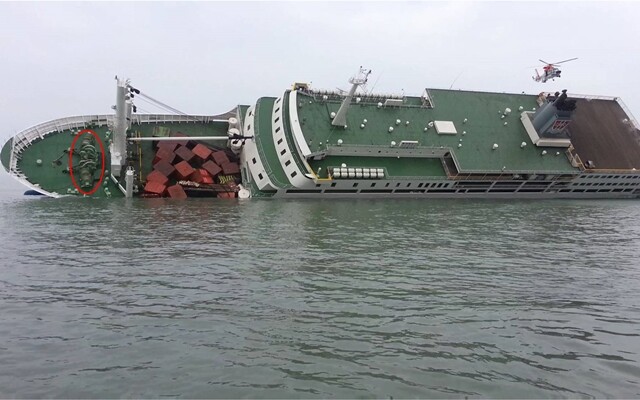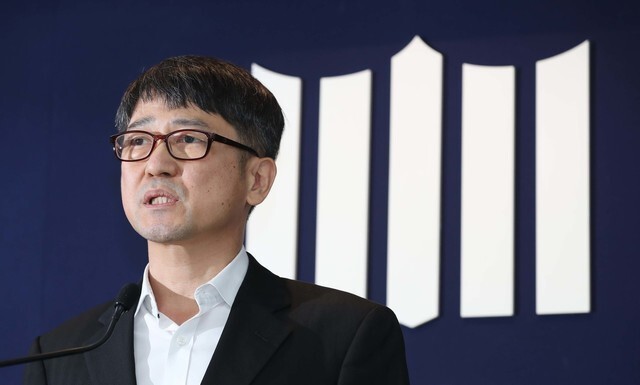hankyoreh
Links to other country sites 다른 나라 사이트 링크
Prosecutors investigating 2014 Sewol sinking to indict 6 former, current Coast Guard leaders

South Korea’s state prosecutors, who are investigating charges related to the botched rescue of passengers on the overturned Sewol ferry in 2014, have asked courts to detain six current and former leaders of the Coast Guard, including Kim Suk-kyoon, who headed the organization at the time of the accident. Prior to this, the only member of the Coast Guard who was indicted was Kim Gyeong-il, former captain of Vessel 123, attached to the Mokpo Coast Guard. During this second wave of investigations into the sinking, prosecutors seem to be holding senior members of the Coast Guard responsible for the mishandling of the rescue.
The special team investigating the Sewol disaster (under Im Gwan-hyeok, head of the Ansan branch of the prosecutors) announced on Jan. 6 that it had requested preliminary detention warrants for coast guard officials on charges including involuntary manslaughter, falsifying official documents, and abuse of power. Along with Kim Suk-kyoon, the other figures named in the warrant requests are Kim Su-hyeon, former head of the Yellow Sea Coast Guard Office; Kim Mun-hong, former head of the Mokpo Coast Guard Office; Lee Chun-jae, a former senior superintendent general in the Coast Guard (head of the Coast Guard’s Security and Safety Bureau at the time of the accident); Yeo In-tae, head of the Jeju Coast Guard (head of the Coast Guard’s security section at the time); and Yu Yeon-sik, a former senior superintendent in the Coast Guard (the officer in charge at the Yellow Sea Coast Guard Office at the time).

These six figures are charged with being negligent in their duty to take the necessary actions to rescue passengers during the Sewol accident, such as ordering them to abandon ship, which resulted in the deaths of 304 passengers and the injuries of 142 others. During their investigation, the prosecutors learned that the Coast Guard leadership had failed to give orders required for the rescue. For one thing, they didn’t assign an aircraft coordinator, who would have overseen airborne search and rescue efforts.
Furthermore, prosecutors contend, the Coast Guard falsified documents so as to exaggerate, or misrepresent, the actual situation during the rescue. A document titled “Contentions About First Response and Search and Rescue,” which was composed by the Coast Guard prior to an audit by the National Assembly, was doctored to cast the Coast Guard in a positive light, suggesting that passengers had been told to evacuate the ship over a loudspeaker during the rescue, even though that didn’t happen. Since launching their investigation on Nov. 11, 2019, the prosecutors have questioned 100 individuals, including Lee Jun-seok, former captain of the ferry, who was convicted of murder and is currently serving a life sentence.
By Lim Jae-woo, staff reporter
Please direct comments or questions to [english@hani.co.kr]

Editorial・opinion
![[Column] The state is back — but is it in business? [Column] The state is back — but is it in business?](https://flexible.img.hani.co.kr/flexible/normal/500/300/imgdb/original/2024/0506/8217149564092725.jpg) [Column] The state is back — but is it in business?
[Column] The state is back — but is it in business?![[Column] Life on our Trisolaris [Column] Life on our Trisolaris](https://flexible.img.hani.co.kr/flexible/normal/500/300/imgdb/original/2024/0505/4817148682278544.jpg) [Column] Life on our Trisolaris
[Column] Life on our Trisolaris- [Editorial] Penalties for airing allegations against Korea’s first lady endanger free press
- [Editorial] Yoon must halt procurement of SM-3 interceptor missiles
- [Guest essay] Maybe Korea’s rapid population decline is an opportunity, not a crisis
- [Column] Can Yoon steer diplomacy with Russia, China back on track?
- [Column] Season 2 of special prosecutor probe may be coming to Korea soon
- [Column] Park Geun-hye déjà vu in Yoon Suk-yeol
- [Editorial] New weight of N. Korea’s nuclear threats makes dialogue all the more urgent
- [Guest essay] The real reason Korea’s new right wants to dub Rhee a founding father
Most viewed articles
- 1[Column] Why Korea’s hard right is fated to lose
- 2Amid US-China clash, Korea must remember its failures in the 19th century, advises scholar
- 3[Column] The state is back — but is it in business?
- 460% of young Koreans see no need to have kids after marriage
- 5Presidential office warns of veto in response to opposition passing special counsel probe act
- 6Japan says it’s not pressuring Naver to sell Line, but Korean insiders say otherwise
- 7[Editorial] Stagnant youth employment poses serious issues for Korea’s future
- 8[Guest essay] Maybe Korea’s rapid population decline is an opportunity, not a crisis
- 9OECD upgrades Korea’s growth forecast from 2.2% to 2.6%
- 10Hybe-Ador dispute shines light on pervasive issues behind K-pop’s tidy facade